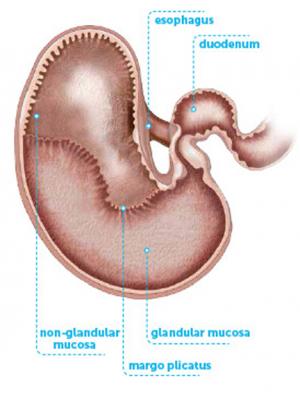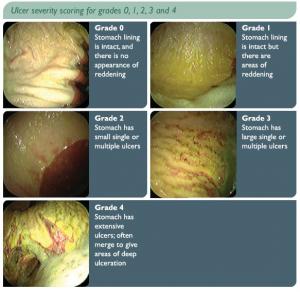By Dr. Allison Forbes, Full Circle Equine Services
What is EGUS?
Ulcers are a common medical condition in horses and foals. It is estimated that 25-50% of foals and 1/3 of adult horses confined in stalls may have mild ulcers. Up to 60% of show and performance horses and 93% of racehorses may develop moderate to severe ulcers. Because they are so common, and can occur as a result of a number of factors, the condition is often called “equine gastric ulcer syndrome” (EGUS). Equine gastric ulcers are erosions of the stomach lining due to prolonged exposure to NORMAL acid in the stomach, vs. human ulcers, which are caused by bacteria. The syndrome can develop in all horses, regardless of age (neonates, weanlings, yearlings, and adults).
The progression of the disease is: Inflammation; Erosion; Ulceration; Perforation.
Prevalence
25–50 % in foals
60% show/performance horses
93% racing thoroughbreds
38 - 56% racing standardbreds
50% of horses with ulcers DO NOT show clinical signs
Anatomy
To understand why horses are prone to ulcers, it is helpful to know some horse anatomy. Holding only about 4 gallons, the horse’s stomach is small compared to humans. It is divided into two distinct parts by the margo plicatus. The non-glandular portion (also called the esophageal region) is lined by tissue similar to the lining of the esophagus. The glandular portion is lined with glandular tissue, which produces hydrochloric acid and pepsin, an enzyme needed for the digestion of food. This part of the digestive system also produces substances to protect the stomach from the effects of the acid and enzymes. In humans, eating stimulates the production of hydrochloric acid. In the horse, however, hydrochloric acid is constantly being produced. So, if a horse does not eat, the acid accumulates in the stomach, and can start to irritate the stomach, especially the non-glandular portion.
Risk Factors
There are multiple factors that can increase the risk of ulcers in horses, including:
In foals, signs of gastric ulcers include:
Diagnosis
If a gastric ulcer is suspected, a veterinarian will use a combination of medical history, clinical signs, laboratory tests, and special examinations to make the diagnosis. Gastric ulcers can be life-threatening. The only way to truly diagnosis ulcers is via endoscopy. Mild sedation is required and, thus, food and water must be withheld for 16 hours prior to examination, which allows stomach to empty for better visualization.
Grading scale 0-4
Gastric ulcers are graded according to severity. Grade 1: Intact epithelium, with mild redness and roughening
Grade 2: Small areas of erosion and ulcerations
Grade 3: Larger, multi-focal areas of erosion and ulcerations
Grade 4: Extensive lesions of deep ulcerations, bleeding seen
Treatments
Medications and changes in management practices are the cornerstones of therapy for equine gastric ulcers. Different medications are used for three purposes: (1) to decrease acid production, (2) to buffer the acid that is produced, and (3) to protect the lining of the stomach from the effects of the acid.
Changes in management are also necessary including:
· Other products: Aloe Vera juice, SmartPak SmartGut Ultra
Many ulcers in foals heal without treatment. In adults, the clinical signs may improve within 1-2 days of starting treatment, but it takes far longer for the ulcer to actually heal. Be sure to follow your veterinarian's treatment recommendations. If you stop the treatment earlier than your veterinarian suggests, the ulcer may not completely heal.
Editor’s Additional Source:
Drs. Foster and Smith, “Equine Gastric Ulcer Syndrome.” http://www.drsfostersmith.com/pic/article.cfm?articleid=1587
What is EGUS?
Ulcers are a common medical condition in horses and foals. It is estimated that 25-50% of foals and 1/3 of adult horses confined in stalls may have mild ulcers. Up to 60% of show and performance horses and 93% of racehorses may develop moderate to severe ulcers. Because they are so common, and can occur as a result of a number of factors, the condition is often called “equine gastric ulcer syndrome” (EGUS). Equine gastric ulcers are erosions of the stomach lining due to prolonged exposure to NORMAL acid in the stomach, vs. human ulcers, which are caused by bacteria. The syndrome can develop in all horses, regardless of age (neonates, weanlings, yearlings, and adults).
The progression of the disease is: Inflammation; Erosion; Ulceration; Perforation.
Prevalence
25–50 % in foals
60% show/performance horses
93% racing thoroughbreds
38 - 56% racing standardbreds
50% of horses with ulcers DO NOT show clinical signs
Anatomy
To understand why horses are prone to ulcers, it is helpful to know some horse anatomy. Holding only about 4 gallons, the horse’s stomach is small compared to humans. It is divided into two distinct parts by the margo plicatus. The non-glandular portion (also called the esophageal region) is lined by tissue similar to the lining of the esophagus. The glandular portion is lined with glandular tissue, which produces hydrochloric acid and pepsin, an enzyme needed for the digestion of food. This part of the digestive system also produces substances to protect the stomach from the effects of the acid and enzymes. In humans, eating stimulates the production of hydrochloric acid. In the horse, however, hydrochloric acid is constantly being produced. So, if a horse does not eat, the acid accumulates in the stomach, and can start to irritate the stomach, especially the non-glandular portion.
Risk Factors
There are multiple factors that can increase the risk of ulcers in horses, including:
- Fasting (not eating) - Horses evolved to graze, eating many small meals frequently. This way, the stomach is rarely empty and the stomach acid has less of a damaging effect. If horses and foals do not eat frequently, the acid builds up and ulcers are more likely to develop.
- Type of feed - The type and amount of roughage play a role in ulcer development. Roughage, because it requires more chewing, stimulates the production of more saliva. The swallowed saliva helps to neutralize stomach acid. There is an increase in acid production when concentrates are fed. The type of roughage is also important. Alfalfa is higher in calcium, and it is thought that this may help decrease the risk of ulcers.
- Amount of exercise - As the amount of exercise increases, there is often a change in feeding (e.g., more times of fasting, less roughage), which increases the risk of ulcer development. In addition, exercise may increase the time it takes for the stomach to empty, so large amounts of acid can remain in an empty stomach for a prolonged period of time. Stress itself may decrease the amount of blood flow to the stomach, which makes the lining of the stomach more vulnerable to injury from stomach acid.
- Medications - Chronic use of non-steroidal anti-inflammatory drugs (NSAIDS) such as phenylbutazone(Bute) and flunixin meglumine (Banamine® Paste) blocks the production of a particular chemical called PgE2. PgE2 decreases acid production, so when PgE2 levels are low, acid levels are high, contributing to the development of ulcers.
In foals, signs of gastric ulcers include:
- Intermittent colic, often after nursing or eating
- Poor appetite and nursing for only very short periods
- Teeth grinding
- Excessive salivation
- Diarrhea
- Lying on the back
- Poor appetite
- Weight loss and poor body condition
- Poor hair coat
- Mild colic
- Mental dullness or attitude changes
- Poor performance
- Lying down more than normal
Diagnosis
If a gastric ulcer is suspected, a veterinarian will use a combination of medical history, clinical signs, laboratory tests, and special examinations to make the diagnosis. Gastric ulcers can be life-threatening. The only way to truly diagnosis ulcers is via endoscopy. Mild sedation is required and, thus, food and water must be withheld for 16 hours prior to examination, which allows stomach to empty for better visualization.
Grading scale 0-4
Gastric ulcers are graded according to severity. Grade 1: Intact epithelium, with mild redness and roughening
Grade 2: Small areas of erosion and ulcerations
Grade 3: Larger, multi-focal areas of erosion and ulcerations
Grade 4: Extensive lesions of deep ulcerations, bleeding seen
Treatments
Medications and changes in management practices are the cornerstones of therapy for equine gastric ulcers. Different medications are used for three purposes: (1) to decrease acid production, (2) to buffer the acid that is produced, and (3) to protect the lining of the stomach from the effects of the acid.
- H2 blockers: These are medications that block the action of histamine. Histamine stimulates the production of stomach acid. Example: Cimetidine, ranitidine.
- Proton pump inhibitors: These are medications that inhibit the production of acid by the stomach (Omeprazole)
- Buffers: Antacids buffer the action of the stomach acid. Because acid is constantly being produced in the horse, antacids are effective for only a short time (less than an hour) and require large amounts be given. This makes them relatively impractical in the horse, though their use on the day of performance or a stressful event may be beneficial. (Carafate, Neighlox)
- Protectants: Certain drugs can block acid from coming into contact with the stomach lining. Unfortunately, these do not appear to be as effective in the esophageal portion of the stomach. (Sucralfate)
Changes in management are also necessary including:
- Increasing the amount of roughage in the diet.
- Feeding Alfalfa hay
- Increasing the number of feedings by increasing the amount of time the horse is actually eating. Putting the horse on pasture would be the best alternative.
- Avoiding or decreasing the amount of grain/concentrates in the diet. Use supplements to add the vitamins and minerals, and vegetable oils to add the calories the horse may need.
- Giving probiotics to aid in digestion.
· Other products: Aloe Vera juice, SmartPak SmartGut Ultra
Many ulcers in foals heal without treatment. In adults, the clinical signs may improve within 1-2 days of starting treatment, but it takes far longer for the ulcer to actually heal. Be sure to follow your veterinarian's treatment recommendations. If you stop the treatment earlier than your veterinarian suggests, the ulcer may not completely heal.
Editor’s Additional Source:
Drs. Foster and Smith, “Equine Gastric Ulcer Syndrome.” http://www.drsfostersmith.com/pic/article.cfm?articleid=1587









